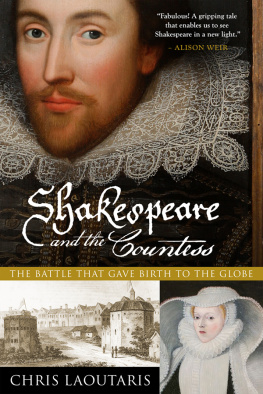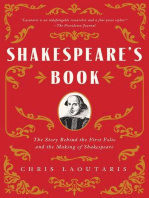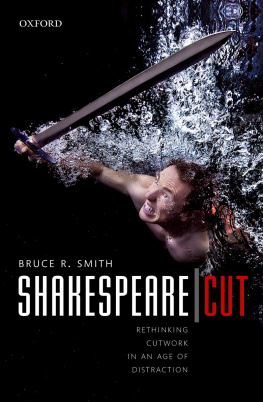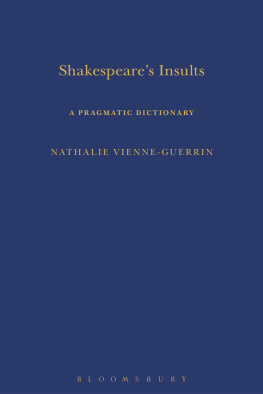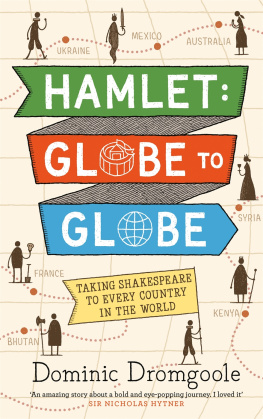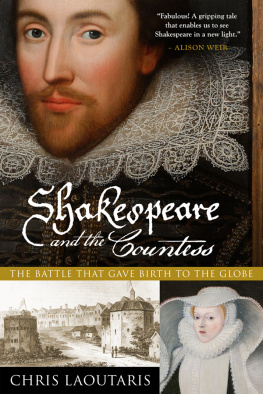
Shakespeare and the Countess
The Battle that Gave Birth to the Globe
CHRIS LAOUTARIS

PEGASUS BOOKS
NEW YORK LONDON
Dedicated to my parents, John and Thalia,
and to the memory of my brother,
George (19752006)

SHAKESPERE AND THE COUNTESS
Pegasus Books LLC
80 Broad Street, 5th Floor
New York, NY 10004
Copyright 2014 by Chris Laoutaris
First Pegasus Books hardcover edition June 2015
All rights reserved. No part of this book may be reproduced in whole or in part without written permission from the publisher, except by reviewers who may quote brief excerpts in connection with a review in a newspaper, magazine, or electronic publication; nor may any part of this book be reproduced, stored in a retrieval system, or transmitted in any form or by any means electronic, mechanical, photocopying, recording, or other, without written permission from the publisher.
ISBN: 978-1-60598-792-7
ISBN: 978-1-60598-793-4 (e-book)
Distributed by W. W. Norton & Company, Inc.
Contents
1. Elizabeth Russells petition to the Privy Council against Shakespeares Blackfriars Theatre, November 1596. State Papers, 12/260, f. 176r. Courtesy of the National Archives, Kew
2. Portrait of Elizabeth (Cooke Hoby) Russell, circle of Robert Peake the Elder, c.15961600. Bisham Abbey, Berkshire.
3. Portrait of William Cecil, 1st Baron Burghley and Lord Treasurer of England, unknown artist, oil on panel, painted after 1587. National Portrait Gallery, London
4. Portrait of Mildred (Cooke) Cecil, Lady Burghley, attributed to Hans Eworth (fl. 154073). Hatfield House, courtesy of the Marquis of Salisbury
5. Portrait of Robert Cecil, by John de Critz the Elder, c. 16068. Hatfield House, courtesy of the Marquis of Salisbury
6. Monument of Charles de Maigny (d. 1557), by Pierre Bontemps (150568). RMN Grand Palais, Muse du Louvre, Paris. Photo: Stphane Marchalle
7. Monument of Sir Thomas Hoby and Sir Philip Hoby, workshop of William Cure, c. 157071. Church of All Saints, Bisham, Berkshire. Photo: Chris Laoutaris
8. Detail from the tomb of Sir Thomas Hoby and Sir Philip Hoby, workshop of William Cure, c.157071. Church of All Saints, Bisham, Berkshire. Photo: Chris Laoutaris
9. Bisham Abbey, Bisham, Berkshire. Photo: Chris Laoutaris
10. Silver medal with portraits of Richard Martin and Dorcas (Eglestone) Martin, by Steven Cornelisz van Herwijck, 1562. Trustees of the British Museum
11. Monument of Sir Anthony Cooke and Anne Fitzwilliam Cooke, workshop of Cornelius Cure, after 11 June 1576. Church of St Edward the Confessor, Romford, Essex. Photo: Patricia Phillippy
12. Detail from the monument of Sir Anthony Cooke and Anne Fitzwilliam Cooke, with relief engraving of the Cooke sisters, workshop of Cornelius Cure, after 11 June 1576. Church of St Edward the Confessor, Romford, Essex. Photo: Patricia Phillippy
13. Elizabeth Russells letter to William More, 9 August c.158081. Surrey History Centre, Woking, Historical Correspondence, 6729/6/98. By kind permission of the More-Molyneux family
14. Richard Fields lease agreement. Surrey History Centre, Woking, Loseley Manuscripts, LM 333/12, 22 September 1592. By kind permission of the More-Molyneux family
15. Monument of John, Lord Russell, Cure workshop, after 23 July 1584. Westminster Abbey, London. Dean and Chapter of Westminster
16. Portrait of Robert Devereux, 2nd Earl of Essex, Marcus Gheeraerts the Younger, c. 1596. Woburn Abbey, Bedfordshire. The Bridgeman Art Library
17. The remains of Donnington Castle, near Newbury, Berkshire. Henry Taunt/English Heritage/Arcaid/Corbis
18. Portrait of the Lord Admiral, Charles Howard, 1st Earl of Nottingham, unknown artist, oil on canvas, 1602. National Portrait Gallery, London
19. Portrait of William Shakespeare, attributed to John Taylor, oil on canvas, 1600s. National Portrait Gallery, London
20. Detail from an engraving by Cornelius de Visscher, showing a theatre labelled The Globe, 1616. British Library, London, UK/ British Library Board. All Rights Reserved/The Bridgeman Art Library
21. Detail from episcopal church visitation records of 15923, MS 9537, vol. 8, f. 77r. By kind permission of the London Metropolitan Archives, City of London/Diocese of London
22. Detail from episcopal church visitation records of 1598, MS 9537, vol. 9, f. 158r. By kind permission of the London Metropolitan Archives, City of London/Diocese of London
23. Section from the Long View of London, Wenceslaus Hollar, 1647 (engraving), showing the Bankside and the Blackfriars. London Metropolitan Archives, City of London/The Bridgeman Art Library
24. Inigo Joness designs for the Cockpit Theatre, Drury Lane. By kind permission of the Provost and Fellows of Worcester College, Oxford
25. Interior of the Sam Wanamaker Playhouse, London, opened in 2014. Photo: Pete Le May
26. Reconstruction of Shakespeares New Place. Reconstruction by Pat Hughes Shakespeare Birthplace Trust
27. Queen Elizabeth I being Carried in Procession (Eliza Triumphans), by Robert Peake, oil on canvas, c. 1601. Private collection / The Bridgeman Art Library
28. Monument of Bess Russell, Cure workshop, after 2 July 1600. Chapel of St Edmund, Westminster Abbey, London. Dean and Chapter of Westminster
29. The Somerset House Conference, unknown artist, oil on canvas, 1604. National Portrait Gallery, London
30. Miniature of an unknown woman, by Nicholas Hilliard, possibly first quarter of the seventeenth century. Private collection
31. Monument of Elizabeth Russell, attributed to the workshop of William Cure II. Church of All Saints, Bisham, Berkshire. Photo: Chris Laoutaris
32. Detail from Elizabeth Russells effigy. Monument of Elizabeth Russell, attributed to the workshop of William Cure II. Church of All Saints, Bisham, Berkshire. Photo: Chris Laoutaris
33. Detail from the effigy of Nan (Russell) Somerset, Lady Herbert. Monument of Elizabeth Russell, attributed to the workshop of William Cure II. Church of All Saints, Bisham, Berkshire. Photo: Chris Laoutaris
34. Detail from the effigies of Edward and Thomas Posthumous Hoby. Monument of Elizabeth Russell, attributed to the workshop of William Cure II. Church of All Saints, Bisham, Berkshire. Photo: Chris Laoutaris
Whenever I encountered a seeming dead-end while following a research trail and came close to giving up, I always found myself asking, What would Elizabeth Russell do? Elizabeth Russell, I inevitably, reassuringly, concluded, would not give up. And so I would press on. While her example gave me the impetus to persist where the historical record seemed at first to be too fragmented to allow me to open a window into her world, I know that this book would not have come into being at all had it not been for the generosity and help of so many others.
This project was made possible thanks to the support of the institutions which funded and hosted my research. A post-doctoral fellowship from the British Academy, held at University College London, enabled me to conduct a detailed exploration of Elizabeth Russells life and the political and religious contexts which gave shape to her activism. A Birmingham Fellowship at The Shakespeare Institute, awarded by the University of Birmingham, allowed me to delve into the complex history of Shakespeares Blackfriars Theatre and the men who joined Elizabeth Russells campaign to prevent it from opening in 1596. This award gave me the opportunity to sift through the archives which underpin the discoveries made in this book, including the precise locations of Elizabeth Russells home and what is almost certainly Richard Fields printing press; Fields professional association with the Church of St Annes in the Blackfriars and with his landlords (which helped me solve the mystery of the printers betrayal of Shakespeare); the identities, business dealings and affiliations of some of Elizabeth Russells backers; and new potential allusions to Elizabeth Russell in Shakespeares plays. I also owe thanks to the Arts and Humanities Research Council for funding the graduate and doctoral study which set me on the path that led to this book.
Next page
